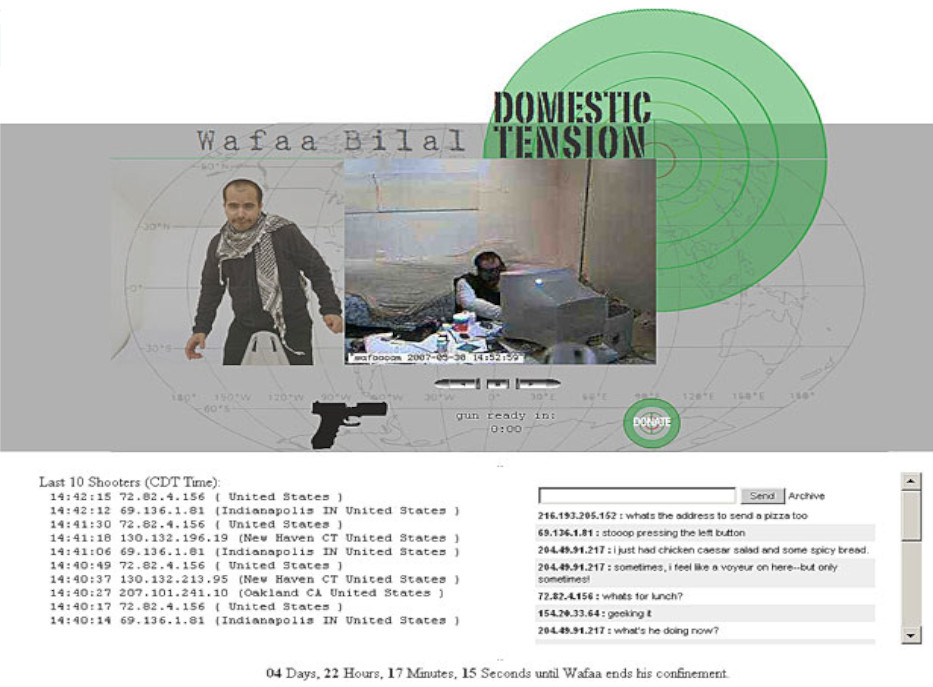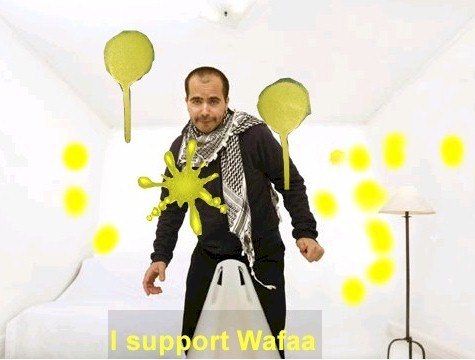This is a screenshot with yellow paint blots. I wrote “I support Wafaa” at the bottom of the photo. He’s the man I wrote a lot about, below.
This post isn’t going to be about Frank Lloyd Wright. Today I want to write about a work of art and how it made me appreciate Memorial Day more than I had before.
In May, 2007 my boyfriend alerted me to something on digg.com. This was an interactive, on-line artwork named “Domestic Tension“: a.k.a. “Shoot an Iraqi”. This was a performance piece by the Iraqi-born American artist, Wafaa Bilal.
As I recall,
Michael said something along the lines of, “Hey, there’s this artist who’s allowing people to shoot him online with a paintball gun.” I imagine that I reacted to this announcement with confusion, then, “Oh, sh*t – the guy’s gonna get everyone and their mother wanting to shoot him.”
Here are some details:
from an article on Bilal by J. Howard Rosier:
For a month, he locked himself in a small room at Chicago’s FlatFile Gallery, where he could be seen around the clock through a camera that he had connected to the web. Bilal set up a remote-controlled paintball gun that viewers could use to shoot him at any time.
https://web.archive.org/web/20230129113320/https://www.saic.edu/magazine/fall21/wafaa-bilal-explores-power-technology
Wafaa Bilal used yellow paintballs. It was based on “tie a yellow ribbon“.
I’ve got a screenshot of what someone would see if they came to the Domestic Tension website:

On the top half of the web page,
you see the rectangular, real-time image of Wafaa Bilal sitting in the gallery with the computer. Below that, you see three icons. Those were the buttons you used to aim the gun and shoot. btw: you could not block anyone from shooting.
The lower left-hand side of the screenshot:
showed you the previous ten shooters, with their IP addresses (their computer addresses), and their locations.
The lower right-hand side of the screenshot:
showed the ongoing chat (with the IP addresses). For the most part, Wafaa just observed (although occasionally he interacted with those—including me—who chatted).
The shooting, and chatting, went on continuously for the 31 days that Wafaa was undertaking this art project.
He only left the room an hour or two every day, usually so that he could attend to personal business (like eating), and post videos on YouTube. His bed was behind a glass partition in the room.
Two more details about the piece:
- It was silent.
- And the color on the walls eventually “washed out” to white.
So, when you looked at the web page, intellectually you knew that there was a constant drumming of shots of yellow paint. However, you could not see the individual shots or hear them. Unless you drove to Chicago to see him in the gallery, or checked out his daily videos in YouTube updates.
I was utterly fascinated.
I thought his work was:
- part performance art,
Performance art because he went through this for a month.
- part conceptual art,
Conceptual art because (from what I remember from my art history classes) there was a breakdown of the “project”, due to the vast amount of information that is being collected. That is, there were the IP addresses of everyone who shot, and an online chat 24/7, for a month.
- and part visual art
The visual art that was created in the gallery space where Wafaa stayed: the yellow paint on the walls (and the constant bombardment) was, itself, a piece of art.
In that way, it reminded me of artists in the early 20th century, and some of the kooky things they did.
The chat:
The online discussion ranged from ridiculous to funny to caring, sublime or disturbing. Its silliness came from people speaking to each other at all times from various parts of the world.
Eventually, a solid group of people organically came together to keep Wafaa intellectually safe.
The conversations concerned questions on the backgrounds of each person participating, but also questions on: was this art, was this provocation, to questions on the war in Iraq, war in general, art in general, et. al.
A volunteer with Wafaa eventually created an “FAQ” page, which was filled in with all of people’s basic questions.
That is: who was he, where did he come from, why was he doing this, how was the project funded, etc.?
After all, the “regulars” knew the answers and didn’t want to have to stop to answer the “newcomers”.1
The gun:
As anyone on the planet could shoot at any time, the paint gun only stopped shooting for about two hours every day. That is: nobody shot when it was nighttime over the Pacific Ocean.
Now, these were only paintballs and originally, he wasn’t against being shot with them. However, getting shot did hurt and he realized this wouldn’t work for a month.
So he mostly stayed below the aim of the gun. But, imagine what it’s like to hear shots at any time for one solid month. Particularly when he couldn’t go outside, or sleep deeply, which had a toll on his mental health.
This caused one portion of “the chatters” to band together and “click left”. That is: they kept clicking the “Left” targeting button to kept the gun pointed away from Wafaa. This group called themselves the “Virtual Human Shield” (or VHS).
The VHS gave birth to another online discussion regarding censorship.
I was amused by all of those who were against the VHS; accusing them of taking away the “point” of Wafaa’s project. I thought, “What, you’re upset because the art isn’t doing what you think it should? Too bad, because this is still the art piece.”
And there were disturbing things:
There were people who came to the chat and called Wafaa a towel-headed camel jockey and every-other-bigoted-slur you can think up for someone from the Middle East.
Or writing in to explicitly say they wanted to shoot the f-ing dirty terrorist Iraqi. Or that they wanted to rape Wafaa’s mother or sister (and I don’t know if he had a sister).
This violent rhetoric was another thing the consistent chatters tried to keep away from Wafaa. I recall times in which chatters began posting lines of poetry, or passages from Shakespeare, in the hope that they would “drown out” those posting violent and racist things.
What does this have to do with Memorial Day?
Wafaa’s work, in the month around Memorial Day, made me think very deeply about the lives of everyone living with the violence in Iraq (and Afghanistan); both civilians and military personnel. And it made me feel close to all of those in Iraq who had to live in that war zone. And, lastly, I thought about the men and women in the military, who had to live with the fear of death through snipers and IEDs.2
After all, Wafaa was inspired to create “Shoot an Iraqi” after seeing footage of someone in the United States who was in the military controlling remote bombs in Iraq. The person could detonate the bombs, but couldn’t hear anything.3 Wafaa’s project (imo) put every person who observed his site into the position of that military person on the other side of the drone and/or bomb.
In addition, Wafaa’s confinement in the gallery alerted those observing him to the sense of confinement felt by those in Iraqi cities and towns.
Some final thoughts:
60,000 paintballs were fired during Domestic Tension. I seem to remember that, with more than a week to go on the art piece, Bilal’s friends drove all over the state of Illinois looking for paintballs. Because of Wafaa, areas of Illinois were completely devoid of the yellow ones. In addition, those chatting created over 3,000 pages of conversations.
See Wafaa:
Take a look at the short video of Wafaa talking about the project, why he started it, what he hoped for it, and what he discovered while doing it:
At the very end of this 2 minute 21 second Youtube segment, he says that the art piece:
… gave me hope in humanity. It gave me hope that when we build a platform for people to have a conversation, they will come and participate.
Wafaa in January 2020, talking in detail about the project:
The follow up question-and-answer portion of Wafaa’s lecture in 2020 is here: https://www.youtube.com/watch?v=6We3S8lEIWM
Pages from Wafaa Bilal’s website about Domestic Tension.
The image at the top of this page is a screenshot, where I took yellow blobs and added them. I don’t recall when I did this, but it was probably the summer of 2007.
Originally posted May 26, 2023.
Notes
1. I did not write any of the answers in the FAQ page.
2. After Wafaa’s project, I have given money to the USO on Memorial Day and Veterans Day whenever I can.
3. I’m reminded of the smart bomb videos from Desert Storm.

